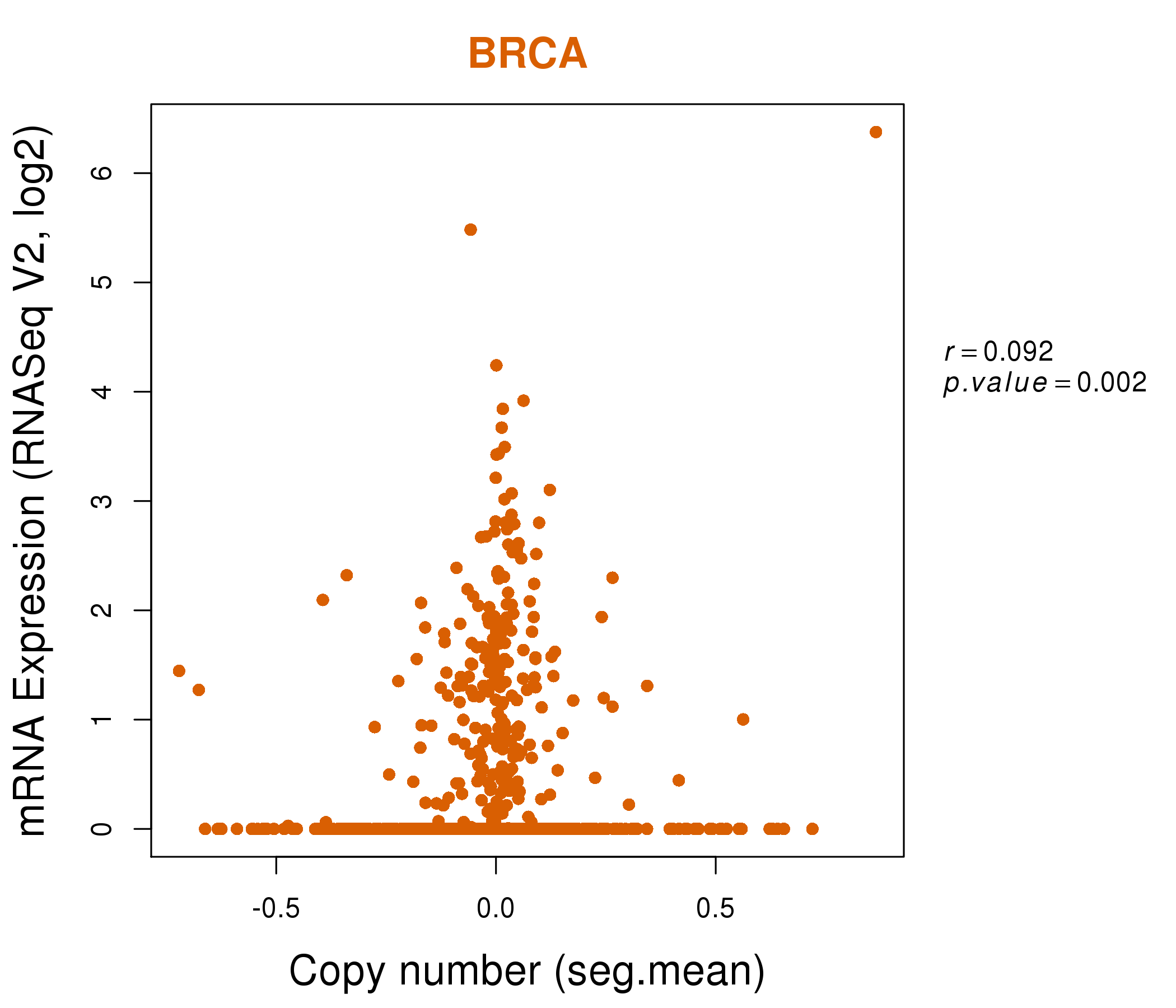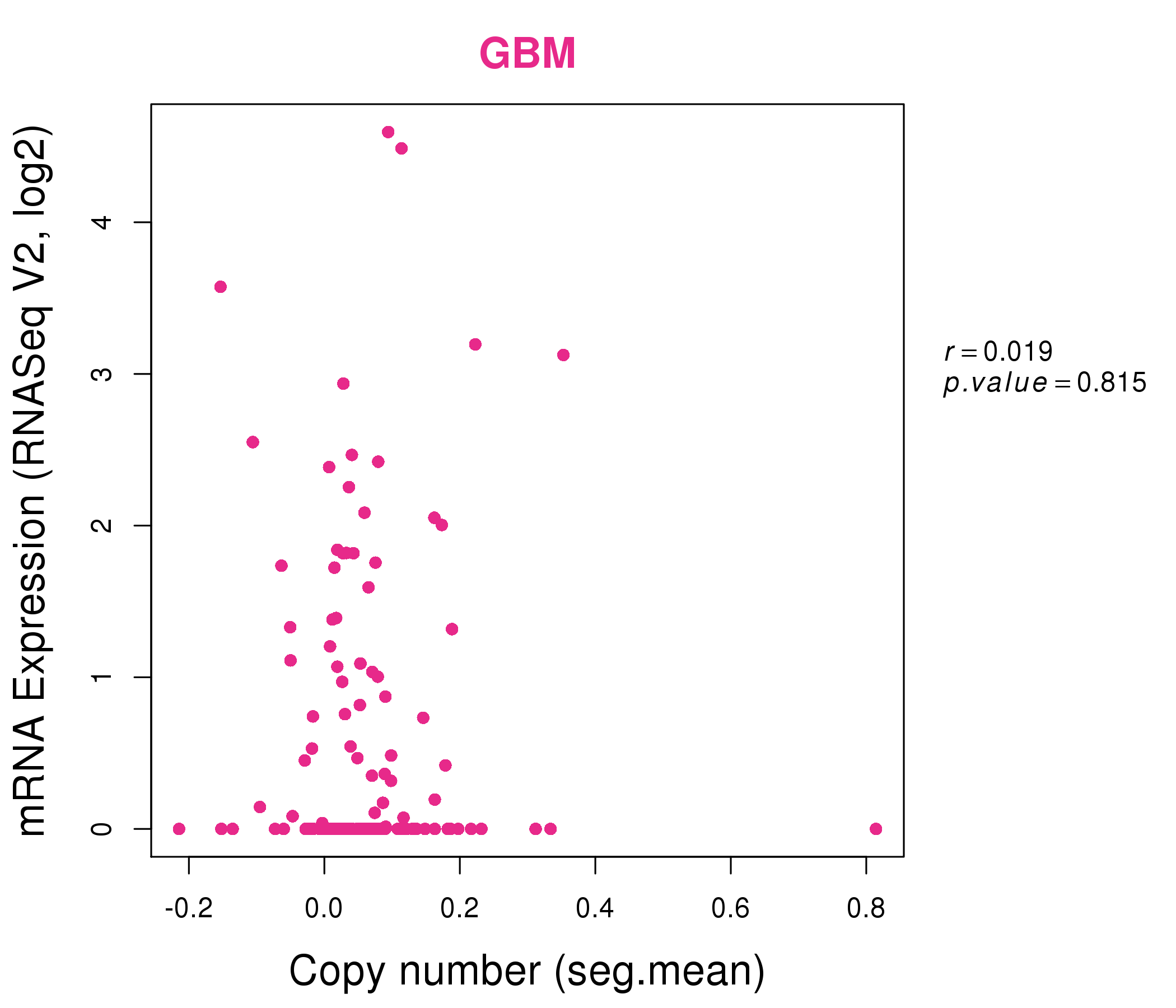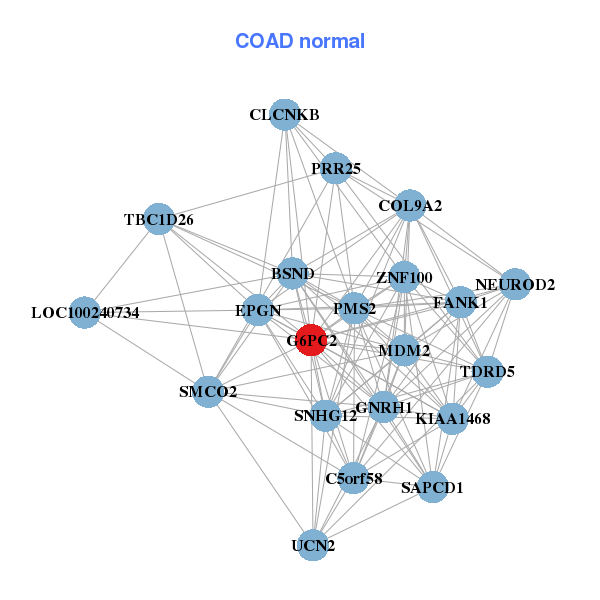|
||||||||||||||||||||
| |
| Phenotypic Information (metabolism pathway, cancer, disease, phenome) |
| |
| |
| Gene-Gene Network Information: Co-Expression Network, Interacting Genes & KEGG |
| |
|
| Gene Summary for G6PC2 |
| Top |
| Phenotypic Information for G6PC2(metabolism pathway, cancer, disease, phenome) |
| Cancer | CGAP: G6PC2 |
| Familial Cancer Database: G6PC2 | |
| * This gene is included in those cancer gene databases. |
|
|
|
|
|
|
| ||||||||||||||
Oncogene 1 | Significant driver gene in | |||||||||||||||||||
| cf) number; DB name 1 Oncogene; http://nar.oxfordjournals.org/content/35/suppl_1/D721.long, 2 Tumor Suppressor gene; https://bioinfo.uth.edu/TSGene/, 3 Cancer Gene Census; http://www.nature.com/nrc/journal/v4/n3/abs/nrc1299.html, 4 CancerGenes; http://nar.oxfordjournals.org/content/35/suppl_1/D721.long, 5 Network of Cancer Gene; http://ncg.kcl.ac.uk/index.php, 1Therapeutic Vulnerabilities in Cancer; http://cbio.mskcc.org/cancergenomics/statius/ |
| KEGG_GLYCOLYSIS_GLUCONEOGENESIS KEGG_GALACTOSE_METABOLISM KEGG_STARCH_AND_SUCROSE_METABOLISM REACTOME_METABOLISM_OF_CARBOHYDRATES | |
| OMIM | |
| Orphanet | |
| Disease | KEGG Disease: G6PC2 |
| MedGen: G6PC2 (Human Medical Genetics with Condition) | |
| ClinVar: G6PC2 | |
| Phenotype | MGI: G6PC2 (International Mouse Phenotyping Consortium) |
| PhenomicDB: G6PC2 | |
| Mutations for G6PC2 |
| * Under tables are showing count per each tissue to give us broad intuition about tissue specific mutation patterns.You can go to the detailed page for each mutation database's web site. |
| There's no structural variation information in COSMIC data for this gene. |
| * From mRNA Sanger sequences, Chitars2.0 arranged chimeric transcripts. This table shows G6PC2 related fusion information. |
| ID | Head Gene | Tail Gene | Accession | Gene_a | qStart_a | qEnd_a | Chromosome_a | tStart_a | tEnd_a | Gene_a | qStart_a | qEnd_a | Chromosome_a | tStart_a | tEnd_a |
| Top |
| There's no copy number variation information in COSMIC data for this gene. |
| Top |
|
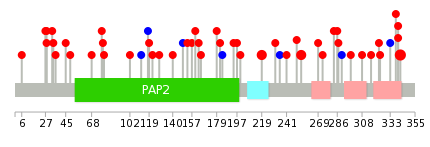 |
| Top |
| Stat. for Non-Synonymous SNVs (# total SNVs=41) | (# total SNVs=5) |
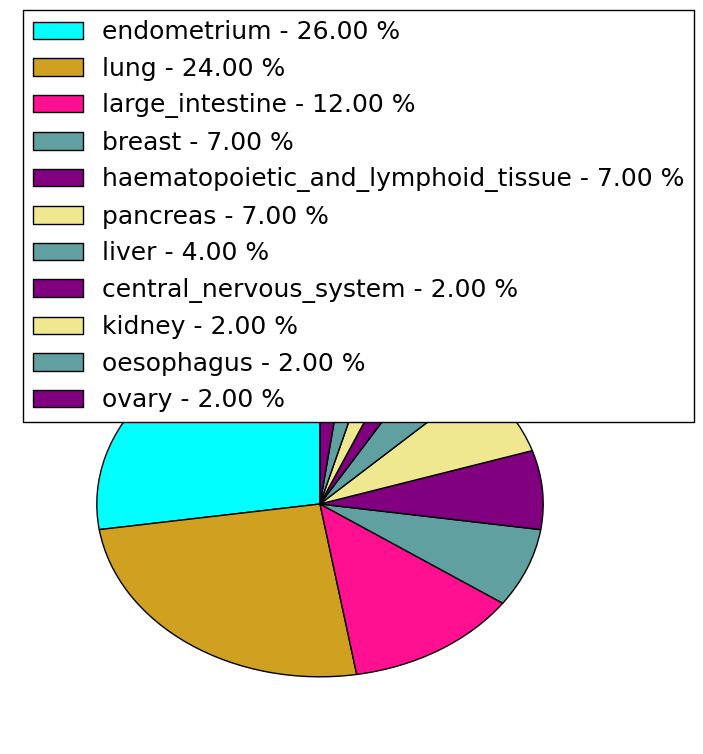 |  |
(# total SNVs=0) | (# total SNVs=0) |
| Top |
| * When you move the cursor on each content, you can see more deailed mutation information on the Tooltip. Those are primary_site,primary_histology,mutation(aa),pubmedID. |
| GRCh37 position | Mutation(aa) | Unique sampleID count |
| chr2:169764546-169764546 | p.S342C | 5 |
| chr2:169764282-169764282 | p.T254M | 3 |
| chr2:169764176-169764176 | p.V219L | 3 |
| chr2:169757987-169757987 | p.F49C | 1 |
| chr2:169764492-169764492 | p.S324Y | 1 |
| chr2:169761050-169761050 | p.V122F | 1 |
| chr2:169763278-169763278 | p.G182E | 1 |
| chr2:169764326-169764326 | p.L269M | 1 |
| chr2:169758043-169758043 | p.N68D | 1 |
| chr2:169764518-169764518 | p.L333L | 1 |
| Top |
|
 |
| Point Mutation/ Tissue ID | 1 | 2 | 3 | 4 | 5 | 6 | 7 | 8 | 9 | 10 | 11 | 12 | 13 | 14 | 15 | 16 | 17 | 18 | 19 | 20 |
| # sample | 2 | 3 | 3 | 6 | 3 | 1 | 4 | 2 | 10 | |||||||||||
| # mutation | 2 | 3 | 3 | 6 | 3 | 1 | 4 | 2 | 12 | |||||||||||
| nonsynonymous SNV | 2 | 3 | 3 | 4 | 3 | 1 | 3 | 1 | 11 | |||||||||||
| synonymous SNV | 2 | 1 | 1 | 1 |
| cf) Tissue ID; Tissue type (1; BLCA[Bladder Urothelial Carcinoma], 2; BRCA[Breast invasive carcinoma], 3; CESC[Cervical squamous cell carcinoma and endocervical adenocarcinoma], 4; COAD[Colon adenocarcinoma], 5; GBM[Glioblastoma multiforme], 6; Glioma Low Grade, 7; HNSC[Head and Neck squamous cell carcinoma], 8; KICH[Kidney Chromophobe], 9; KIRC[Kidney renal clear cell carcinoma], 10; KIRP[Kidney renal papillary cell carcinoma], 11; LAML[Acute Myeloid Leukemia], 12; LUAD[Lung adenocarcinoma], 13; LUSC[Lung squamous cell carcinoma], 14; OV[Ovarian serous cystadenocarcinoma ], 15; PAAD[Pancreatic adenocarcinoma], 16; PRAD[Prostate adenocarcinoma], 17; SKCM[Skin Cutaneous Melanoma], 18:STAD[Stomach adenocarcinoma], 19:THCA[Thyroid carcinoma], 20:UCEC[Uterine Corpus Endometrial Carcinoma]) |
| Top |
| * We represented just top 10 SNVs. When you move the cursor on each content, you can see more deailed mutation information on the Tooltip. Those are primary_site, primary_histology, mutation(aa), pubmedID. |
| Genomic Position | Mutation(aa) | Unique sampleID count |
| chr2:169759040 | p.E316K | 1 |
| chr2:169764111 | p.L153I | 1 |
| chr2:169764488 | p.L323M | 1 |
| chr2:169761040 | p.I160S | 1 |
| chr2:169764212 | p.S324Y | 1 |
| chr2:169764492 | p.S163R | 1 |
| chr2:169761041 | p.F325I | 1 |
| chr2:169764226 | p.N27K,G6PC2 | 1 |
| chr2:169757922 | p.C165R | 1 |
| chr2:169764494 | p.P332P | 1 |
| * Copy number data were extracted from TCGA using R package TCGA-Assembler. The URLs of all public data files on TCGA DCC data server were gathered on Jan-05-2015. Function ProcessCNAData in TCGA-Assembler package was used to obtain gene-level copy number value which is calculated as the average copy number of the genomic region of a gene. |
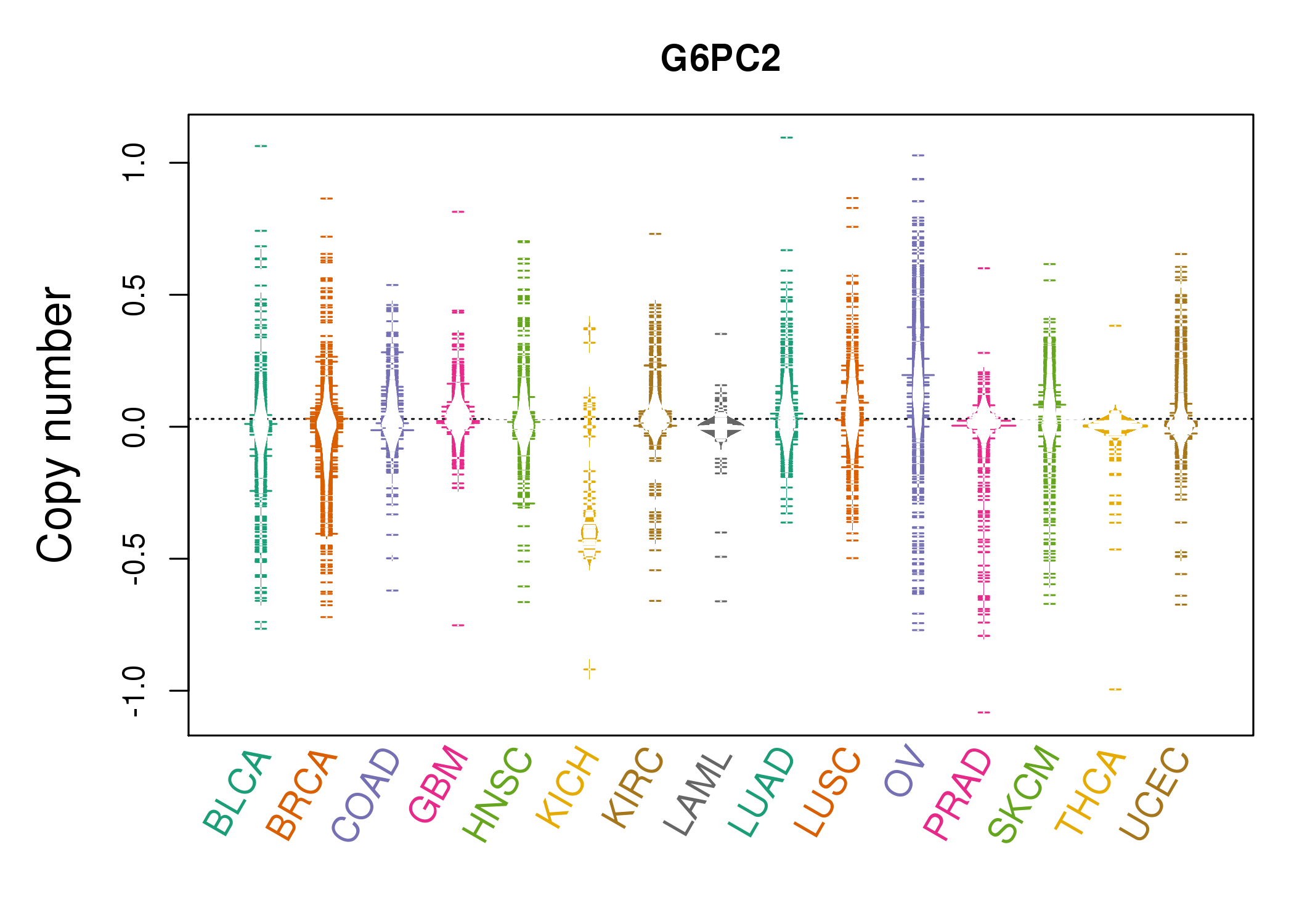 |
| cf) Tissue ID[Tissue type]: BLCA[Bladder Urothelial Carcinoma], BRCA[Breast invasive carcinoma], CESC[Cervical squamous cell carcinoma and endocervical adenocarcinoma], COAD[Colon adenocarcinoma], GBM[Glioblastoma multiforme], Glioma Low Grade, HNSC[Head and Neck squamous cell carcinoma], KICH[Kidney Chromophobe], KIRC[Kidney renal clear cell carcinoma], KIRP[Kidney renal papillary cell carcinoma], LAML[Acute Myeloid Leukemia], LUAD[Lung adenocarcinoma], LUSC[Lung squamous cell carcinoma], OV[Ovarian serous cystadenocarcinoma ], PAAD[Pancreatic adenocarcinoma], PRAD[Prostate adenocarcinoma], SKCM[Skin Cutaneous Melanoma], STAD[Stomach adenocarcinoma], THCA[Thyroid carcinoma], UCEC[Uterine Corpus Endometrial Carcinoma] |
| Top |
| Gene Expression for G6PC2 |
| * CCLE gene expression data were extracted from CCLE_Expression_Entrez_2012-10-18.res: Gene-centric RMA-normalized mRNA expression data. |
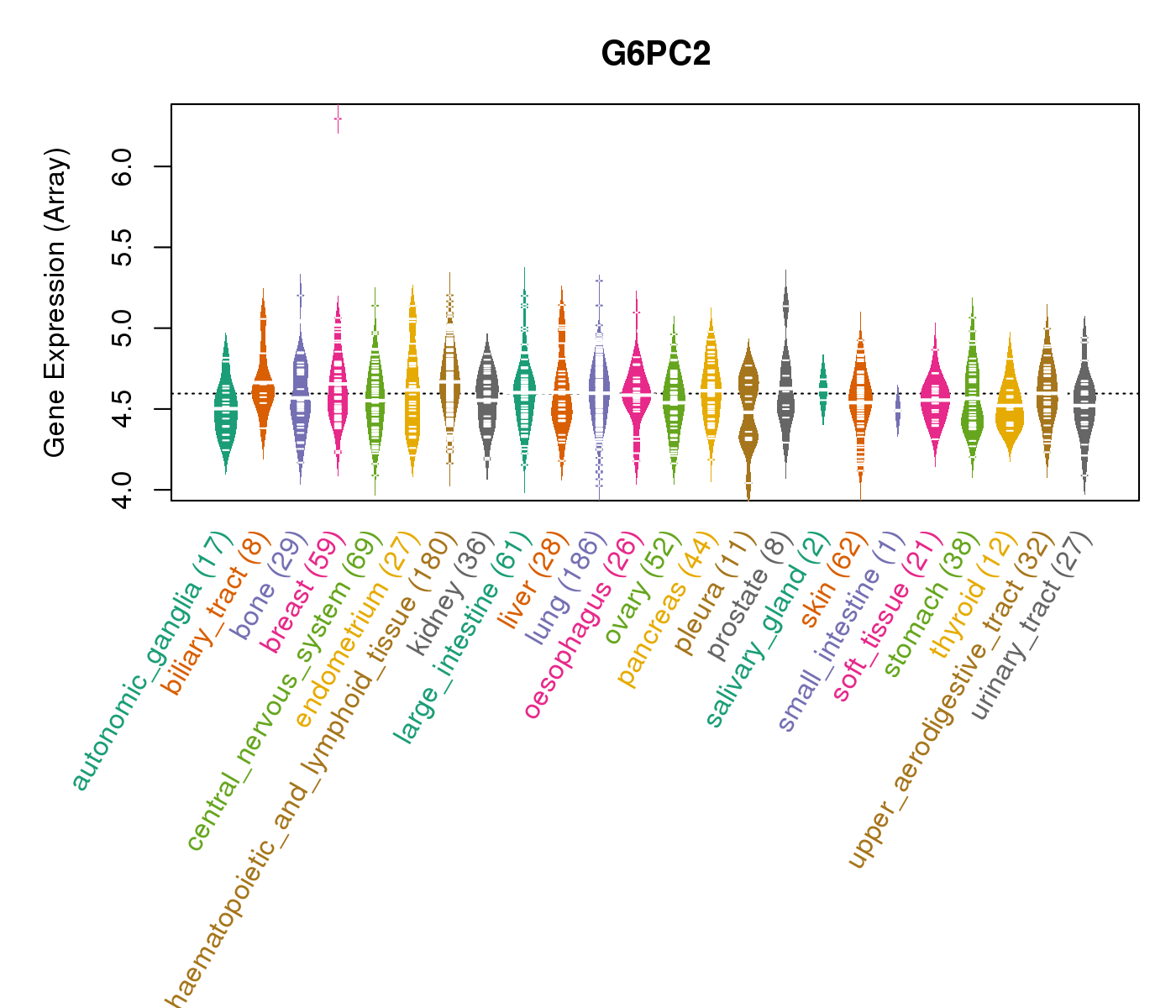 |
| * Normalized gene expression data of RNASeqV2 was extracted from TCGA using R package TCGA-Assembler. The URLs of all public data files on TCGA DCC data server were gathered at Jan-05-2015. Only eight cancer types have enough normal control samples for differential expression analysis. (t test, adjusted p<0.05 (using Benjamini-Hochberg FDR)) |
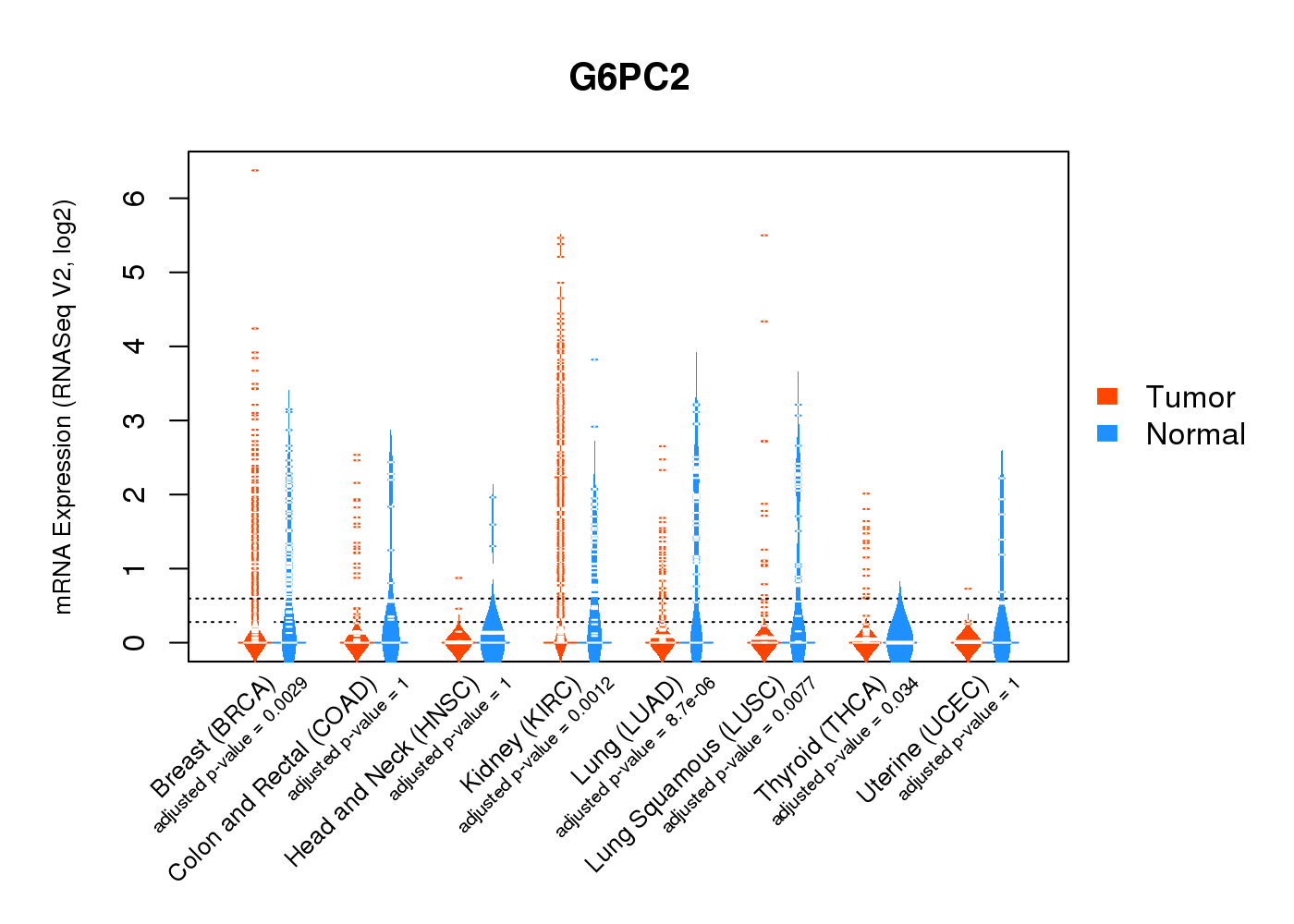 |
| Top |
| * This plots show the correlation between CNV and gene expression. |
: Open all plots for all cancer types
 |
|
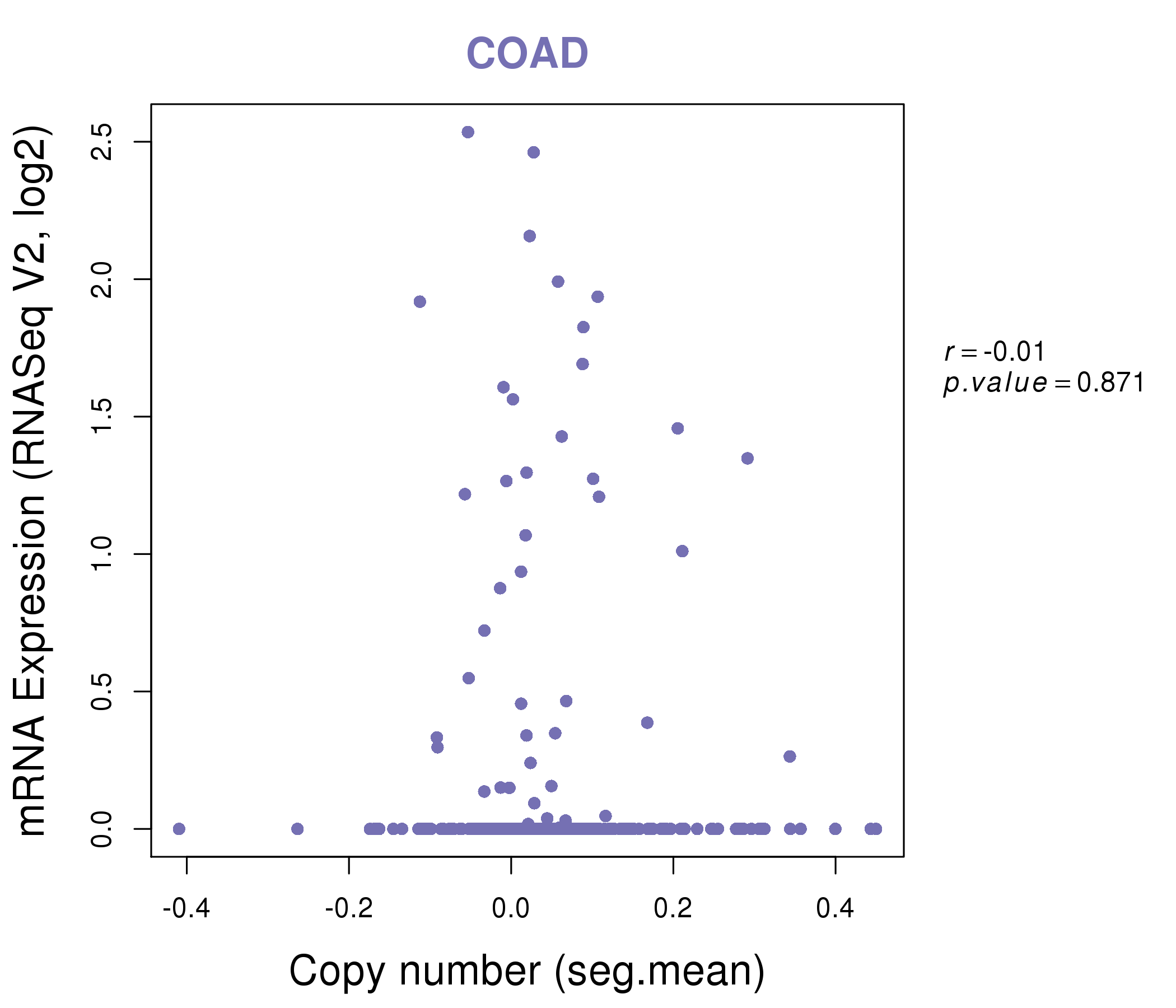 |
|
| Top |
| Gene-Gene Network Information |
| * Co-Expression network figures were drawn using R package igraph. Only the top 20 genes with the highest correlations were shown. Red circle: input gene, orange circle: cell metabolism gene, sky circle: other gene |
: Open all plots for all cancer types
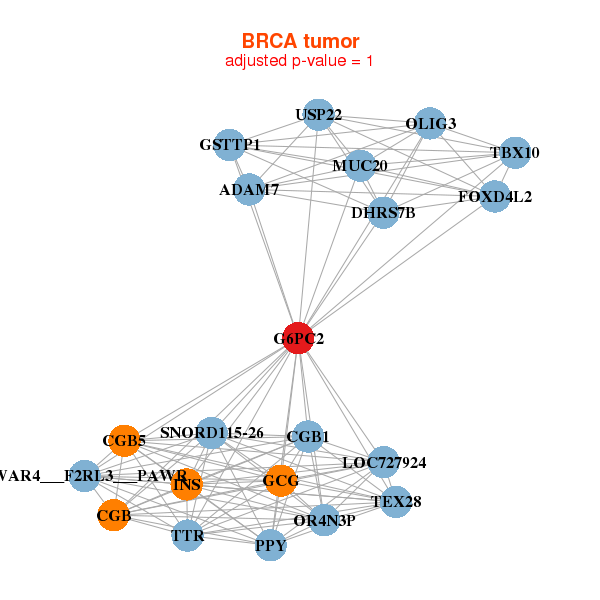 |
|
| ADAM7,CGB,CGB1,CGB5,DHRS7B,FOXD4L2,G6PC2, GCG,GSTTP1,INS,LOC727924,MUC20,OLIG3,OR4N3P, PWAR4___F2RL3___PAWR,PPY,SNORD115-26,TBX10,TEX28,TTR,USP22 | AOX2P,PP2D1,CGB2,EP400NL,FLJ10213,G6PC2,GRM8, HELT,HPVC1,IAPP,LOC283922,LOC91948,LRGUK,NRSN1, OR10H1,OR10J5,OR5P2,PCDHGB2,PRDM7,SLC6A19,USH2A |
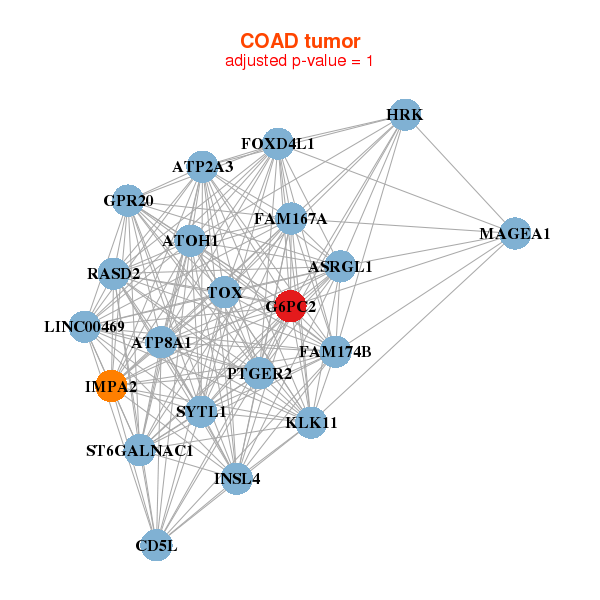 |
|
| ASRGL1,ATOH1,ATP2A3,ATP8A1,LINC00469,CD5L,FAM167A, FAM174B,FOXD4L1,G6PC2,GPR20,HRK,IMPA2,INSL4, KLK11,MAGEA1,PTGER2,RASD2,ST6GALNAC1,SYTL1,TOX | BSND,SMCO2,C5orf58,SAPCD1,CLCNKB,COL9A2,EPGN, FANK1,G6PC2,GNRH1,KIAA1468,LOC100240734,MDM2,NEUROD2, PMS2,PRR25,SNHG12,TBC1D26,TDRD5,UCN2,ZNF100 |
| * Co-Expression network figures were drawn using R package igraph. Only the top 20 genes with the highest correlations were shown. Red circle: input gene, orange circle: cell metabolism gene, sky circle: other gene |
: Open all plots for all cancer types
| Top |
: Open all interacting genes' information including KEGG pathway for all interacting genes from DAVID
| Top |
| Pharmacological Information for G6PC2 |
| There's no related Drug. |
| Top |
| Cross referenced IDs for G6PC2 |
| * We obtained these cross-references from Uniprot database. It covers 150 different DBs, 18 categories. http://www.uniprot.org/help/cross_references_section |
: Open all cross reference information
|
Copyright © 2016-Present - The Univsersity of Texas Health Science Center at Houston @ |






